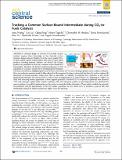| dc.contributor.author | Liu, Can | |
| dc.contributor.author | Peng, Qiling | |
| dc.contributor.author | Yaguchi, Momo | |
| dc.contributor.author | Motobayashi, Kenta | |
| dc.contributor.author | Ye, Shen | |
| dc.contributor.author | Osawa, Masatoshi | |
| dc.contributor.author | Wuttig, Anna | |
| dc.contributor.author | Hendon, Christopher H | |
| dc.contributor.author | Surendranath, Yogesh | |
| dc.date.accessioned | 2018-02-13T18:40:56Z | |
| dc.date.available | 2018-02-13T18:40:56Z | |
| dc.date.issued | 2018-02-13 | |
| dc.identifier.issn | 2374-7943 | |
| dc.identifier.issn | 2374-7951 | |
| dc.identifier.uri | http://hdl.handle.net/1721.1/113632 | |
| dc.description.abstract | Rational design of selective CO₂-to-fuels electrocatalysts requires direct knowledge of the electrode surface structure during turnover. Metallic Cu is the most versatile CO₂ -to-fuels catalyst, capable of generating a wide array of value-added products, including methane, ethylene, and ethanol. All of these products are postulated to form via a common surface-bound CO intermediate. Therefore, the kinetics and thermodynamics of CO adsorption to Cu play a central role in determining fuel-formation selectivity and efficiency, highlighting the need for direct observation of CO surface binding equilibria under catalytic conditions. Here, we synthesize nanostructured Cu films adhered to IR-transparent Si prisms, and we find that these Cu surfaces enhance IR absorption of bound molecules. Using these films as electrodes, we examine Cu-catalyzed CO₂ reduction in situ via IR spectroelectrochemistry. We observe that Cu surfaces bind electrogenerated CO, derived from CO₂, beginning at -0.60 V vs RHE with increasing surface population at more negative potentials. Adsorbed CO is in dynamic equilibrium with dissolved 13 CO and exchanges rapidly under catalytic conditions. The CO adsorption profiles are pH independent, but adsorbed CO species undergo a reversible transformation on the surface in modestly alkaline electrolytes. These studies establish the potential, concentration, and pH dependencies of the CO surface population on Cu, which serve to maintain a pool of this vital intermediate primed for further reduction to higher order fuel products. | en_US |
| dc.description.sponsorship | United States. Air Force Office of Scientific Research (Award FA9550-15-1-0135) | en_US |
| dc.publisher | American Chemical Society (ACS) | en_US |
| dc.relation.isversionof | http://dx.doi.org/10.1021/ACSCENTSCI.6B00155 | en_US |
| dc.rights | Article is made available in accordance with the publisher's policy and may be subject to US copyright law. Please refer to the publisher's site for terms of use. | en_US |
| dc.source | ACS | en_US |
| dc.title | Tracking a Common Surface-Bound Intermediate During CO₂-to-Fuels Catalysis | en_US |
| dc.type | Article | en_US |
| dc.identifier.citation | Wuttig, Anna et al. “Tracking a Common Surface-Bound Intermediate During CO₂-to-Fuels Catalysis.” ACS Central Science 2, 8 (August 2016): 522–528 © 2016 American Chemical Society | en_US |
| dc.contributor.department | Massachusetts Institute of Technology. Department of Chemistry | en_US |
| dc.contributor.mitauthor | Wuttig, Anna | |
| dc.contributor.mitauthor | Hendon, Christopher H | |
| dc.contributor.mitauthor | Surendranath, Yogesh | |
| dc.relation.journal | ACS Central Science | en_US |
| dc.eprint.version | Final published version | en_US |
| dc.type.uri | http://purl.org/eprint/type/JournalArticle | en_US |
| eprint.status | http://purl.org/eprint/status/PeerReviewed | en_US |
| dc.date.updated | 2018-02-08T16:46:41Z | |
| dspace.orderedauthors | Wuttig, Anna; Liu, Can; Peng, Qiling; Yaguchi, Momo; Hendon, Christopher H.; Motobayashi, Kenta; Ye, Shen; Osawa, Masatoshi; Surendranath, Yogesh | en_US |
| dspace.embargo.terms | N | en_US |
| dc.identifier.orcid | https://orcid.org/0000-0001-9519-7907 | |
| dc.identifier.orcid | https://orcid.org/0000-0003-1016-3420 | |
| mit.license | PUBLISHER_POLICY | en_US |
